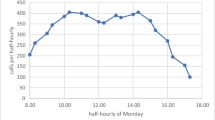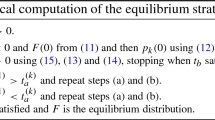Summary
This paper studies the behaviour of a double channel queueing system wherein the arrivals are (i) uncorrelated and (ii) correlated at the two consecutive transition marks; and the intertransition time distribution is exponential.Laplace transforms of the probability generating functions for the queue length are obtained and the steady state results are derived therefrom.
Zusammenfassung
In dieser Arbeit wird das Verhalten eines Zwei-Kanal-Warteschlangensystems untersucht, in dem die Ankünfte an zwei aufeinanderfolgenden Übergangsstellen (1) unkorreliert und (2) korreliert sind; die Übergangszeit ist exponentialverteilt. Es werdenLaplace-Transformationen der Wahrscheinlichkeitsfunktionen für die Länge der Warteschlange ermittelt und daraus die entsprechenden Ergebnisse für den Gleichgewichtszustand abgeleitet.
Similar content being viewed by others
References
Cox, D. R., andW. L. Smith, Queues. New York 1961.
Saaty, T. L.: Elements of Queueing Theory with Applications, McGraw-Hill Book Company, Inc., New York 1961.
Author information
Authors and Affiliations
Rights and permissions
About this article
Cite this article
Sharma, S.D. A continuous time queueing problem with special type of parallel channels. Zeitschrift für Operations Research 19, 125–129 (1975). https://doi.org/10.1007/BF01957173
Received:
Revised:
Issue Date:
DOI: https://doi.org/10.1007/BF01957173




